Francesco Osborne
A Hybrid AI Methodology for Generating Ontologies of Research Topics from Scientific Paper Corpora
Aug 06, 2025Abstract:Taxonomies and ontologies of research topics (e.g., MeSH, UMLS, CSO, NLM) play a central role in providing the primary framework through which intelligent systems can explore and interpret the literature. However, these resources have traditionally been manually curated, a process that is time-consuming, prone to obsolescence, and limited in granularity. This paper presents Sci-OG, a semi-auto\-mated methodology for generating research topic ontologies, employing a multi-step approach: 1) Topic Discovery, extracting potential topics from research papers; 2) Relationship Classification, determining semantic relationships between topic pairs; and 3) Ontology Construction, refining and organizing topics into a structured ontology. The relationship classification component, which constitutes the core of the system, integrates an encoder-based language model with features describing topic occurrence in the scientific literature. We evaluate this approach against a range of alternative solutions using a dataset of 21,649 manually annotated semantic triples. Our method achieves the highest F1 score (0.951), surpassing various competing approaches, including a fine-tuned SciBERT model and several LLM baselines, such as the fine-tuned GPT4-mini. Our work is corroborated by a use case which illustrates the practical application of our system to extend the CSO ontology in the area of cybersecurity. The presented solution is designed to improve the accessibility, organization, and analysis of scientific knowledge, thereby supporting advancements in AI-enabled literature management and research exploration.
A Comparative Study of Task Adaptation Techniques of Large Language Models for Identifying Sustainable Development Goals
Jun 18, 2025Abstract:In 2012, the United Nations introduced 17 Sustainable Development Goals (SDGs) aimed at creating a more sustainable and improved future by 2030. However, tracking progress toward these goals is difficult because of the extensive scale and complexity of the data involved. Text classification models have become vital tools in this area, automating the analysis of vast amounts of text from a variety of sources. Additionally, large language models (LLMs) have recently proven indispensable for many natural language processing tasks, including text classification, thanks to their ability to recognize complex linguistic patterns and semantics. This study analyzes various proprietary and open-source LLMs for a single-label, multi-class text classification task focused on the SDGs. Then, it also evaluates the effectiveness of task adaptation techniques (i.e., in-context learning approaches), namely Zero-Shot and Few-Shot Learning, as well as Fine-Tuning within this domain. The results reveal that smaller models, when optimized through prompt engineering, can perform on par with larger models like OpenAI's GPT (Generative Pre-trained Transformer).
Optimizing Large Language Models for ESG Activity Detection in Financial Texts
Feb 28, 2025Abstract:The integration of Environmental, Social, and Governance (ESG) factors into corporate decision-making is a fundamental aspect of sustainable finance. However, ensuring that business practices align with evolving regulatory frameworks remains a persistent challenge. AI-driven solutions for automatically assessing the alignment of sustainability reports and non-financial disclosures with specific ESG activities could greatly support this process. Yet, this task remains complex due to the limitations of general-purpose Large Language Models (LLMs) in domain-specific contexts and the scarcity of structured, high-quality datasets. In this paper, we investigate the ability of current-generation LLMs to identify text related to environmental activities. Furthermore, we demonstrate that their performance can be significantly enhanced through fine-tuning on a combination of original and synthetically generated data. To this end, we introduce ESG-Activities, a benchmark dataset containing 1,325 labelled text segments classified according to the EU ESG taxonomy. Our experimental results show that fine-tuning on ESG-Activities significantly enhances classification accuracy, with open models such as Llama 7B and Gemma 7B outperforming large proprietary solutions in specific configurations. These findings have important implications for financial analysts, policymakers, and AI researchers seeking to enhance ESG transparency and compliance through advanced natural language processing techniques.
Large Language Models for Scholarly Ontology Generation: An Extensive Analysis in the Engineering Field
Dec 11, 2024Abstract:Ontologies of research topics are crucial for structuring scientific knowledge, enabling scientists to navigate vast amounts of research, and forming the backbone of intelligent systems such as search engines and recommendation systems. However, manual creation of these ontologies is expensive, slow, and often results in outdated and overly general representations. As a solution, researchers have been investigating ways to automate or semi-automate the process of generating these ontologies. This paper offers a comprehensive analysis of the ability of large language models (LLMs) to identify semantic relationships between different research topics, which is a critical step in the development of such ontologies. To this end, we developed a gold standard based on the IEEE Thesaurus to evaluate the task of identifying four types of relationships between pairs of topics: broader, narrower, same-as, and other. Our study evaluates the performance of seventeen LLMs, which differ in scale, accessibility (open vs. proprietary), and model type (full vs. quantised), while also assessing four zero-shot reasoning strategies. Several models have achieved outstanding results, including Mixtral-8x7B, Dolphin-Mistral-7B, and Claude 3 Sonnet, with F1-scores of 0.847, 0.920, and 0.967, respectively. Furthermore, our findings demonstrate that smaller, quantised models, when optimised through prompt engineering, can deliver performance comparable to much larger proprietary models, while requiring significantly fewer computational resources.
A Survey on Knowledge Organization Systems of Research Fields: Resources and Challenges
Sep 06, 2024
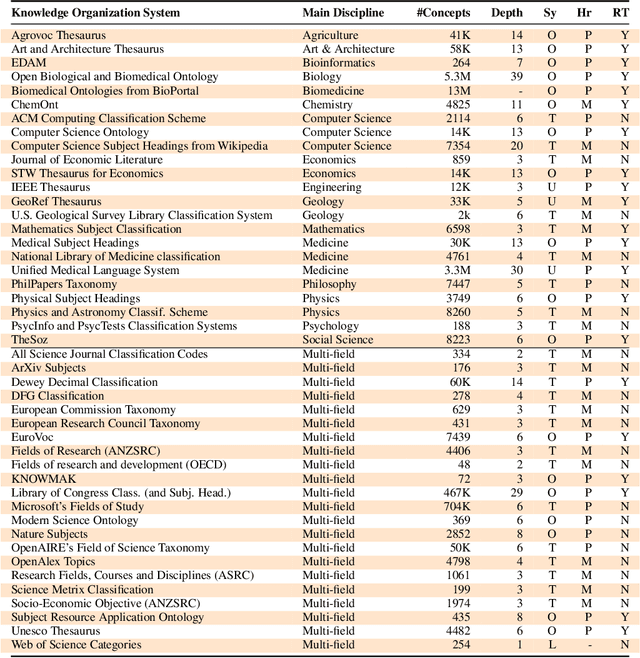
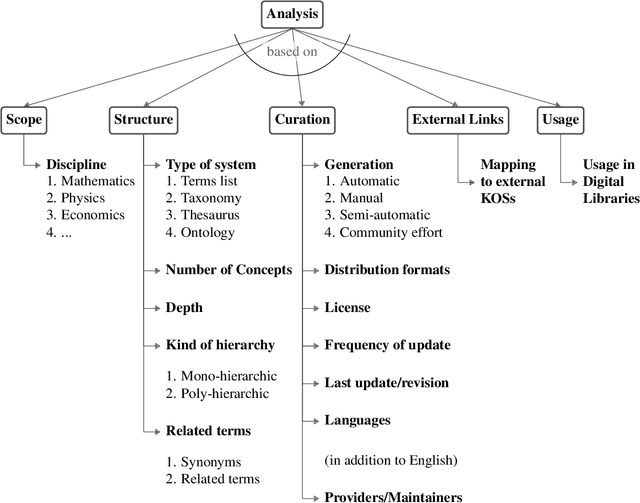
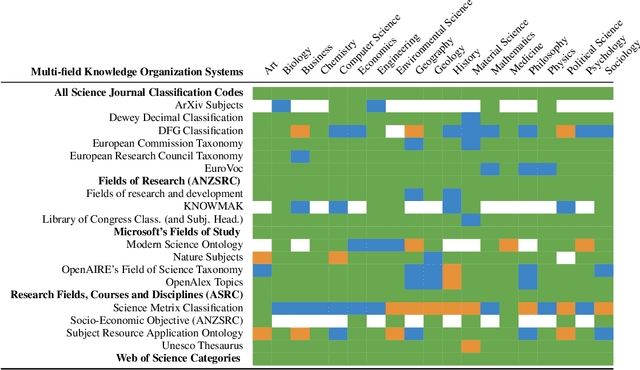
Abstract:Knowledge Organization Systems (KOSs), such as term lists, thesauri, taxonomies, and ontologies, play a fundamental role in categorising, managing, and retrieving information. In the academic domain, KOSs are often adopted for representing research areas and their relationships, primarily aiming to classify research articles, academic courses, patents, books, scientific venues, domain experts, grants, software, experiment materials, and several other relevant products and agents. These structured representations of research areas, widely embraced by many academic fields, have proven effective in empowering AI-based systems to i) enhance retrievability of relevant documents, ii) enable advanced analytic solutions to quantify the impact of academic research, and iii) analyse and forecast research dynamics. This paper aims to present a comprehensive survey of the current KOS for academic disciplines. We analysed and compared 45 KOSs according to five main dimensions: scope, structure, curation, usage, and links to other KOSs. Our results reveal a very heterogeneous scenario in terms of scope, scale, quality, and usage, highlighting the need for more integrated solutions for representing research knowledge across academic fields. We conclude by discussing the main challenges and the most promising future directions.
Triplètoile: Extraction of Knowledge from Microblogging Text
Aug 27, 2024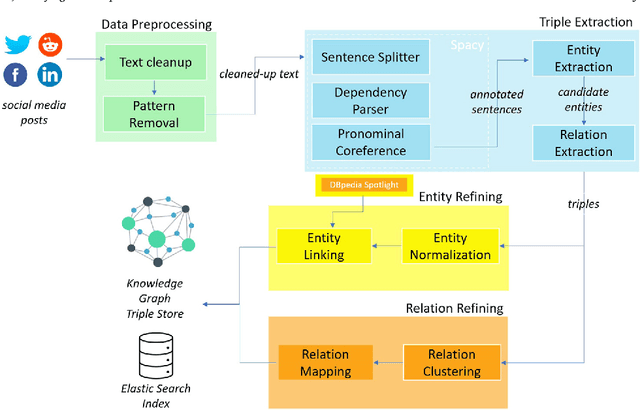



Abstract:Numerous methods and pipelines have recently emerged for the automatic extraction of knowledge graphs from documents such as scientific publications and patents. However, adapting these methods to incorporate alternative text sources like micro-blogging posts and news has proven challenging as they struggle to model open-domain entities and relations, typically found in these sources. In this paper, we propose an enhanced information extraction pipeline tailored to the extraction of a knowledge graph comprising open-domain entities from micro-blogging posts on social media platforms. Our pipeline leverages dependency parsing and classifies entity relations in an unsupervised manner through hierarchical clustering over word embeddings. We provide a use case on extracting semantic triples from a corpus of 100 thousand tweets about digital transformation and publicly release the generated knowledge graph. On the same dataset, we conduct two experimental evaluations, showing that the system produces triples with precision over 95% and outperforms similar pipelines of around 5% in terms of precision, while generating a comparatively higher number of triples.
* 42 pages, 6 figures
Artificial Intelligence for Literature Reviews: Opportunities and Challenges
Feb 13, 2024



Abstract:This manuscript presents a comprehensive review of the use of Artificial Intelligence (AI) in Systematic Literature Reviews (SLRs). A SLR is a rigorous and organised methodology that assesses and integrates previous research on a given topic. Numerous tools have been developed to assist and partially automate the SLR process. The increasing role of AI in this field shows great potential in providing more effective support for researchers, moving towards the semi-automatic creation of literature reviews. Our study focuses on how AI techniques are applied in the semi-automation of SLRs, specifically in the screening and extraction phases. We examine 21 leading SLR tools using a framework that combines 23 traditional features with 11 AI features. We also analyse 11 recent tools that leverage large language models for searching the literature and assisting academic writing. Finally, the paper discusses current trends in the field, outlines key research challenges, and suggests directions for future research.
Knowledge Graphs: Opportunities and Challenges
Mar 24, 2023Abstract:With the explosive growth of artificial intelligence (AI) and big data, it has become vitally important to organize and represent the enormous volume of knowledge appropriately. As graph data, knowledge graphs accumulate and convey knowledge of the real world. It has been well-recognized that knowledge graphs effectively represent complex information; hence, they rapidly gain the attention of academia and industry in recent years. Thus to develop a deeper understanding of knowledge graphs, this paper presents a systematic overview of this field. Specifically, we focus on the opportunities and challenges of knowledge graphs. We first review the opportunities of knowledge graphs in terms of two aspects: (1) AI systems built upon knowledge graphs; (2) potential application fields of knowledge graphs. Then, we thoroughly discuss severe technical challenges in this field, such as knowledge graph embeddings, knowledge acquisition, knowledge graph completion, knowledge fusion, and knowledge reasoning. We expect that this survey will shed new light on future research and the development of knowledge graphs.
Characterising Research Areas in the field of AI
May 26, 2022
Abstract:Interest in Artificial Intelligence (AI) continues to grow rapidly, hence it is crucial to support researchers and organisations in understanding where AI research is heading. In this study, we conducted a bibliometric analysis on 257K articles in AI, retrieved from OpenAlex. We identified the main conceptual themes by performing clustering analysis on the co-occurrence network of topics. Finally, we observed how such themes evolved over time. The results highlight the growing academic interest in research themes like deep learning, machine learning, and internet of things.
Trans4E: Link Prediction on Scholarly Knowledge Graphs
Jul 03, 2021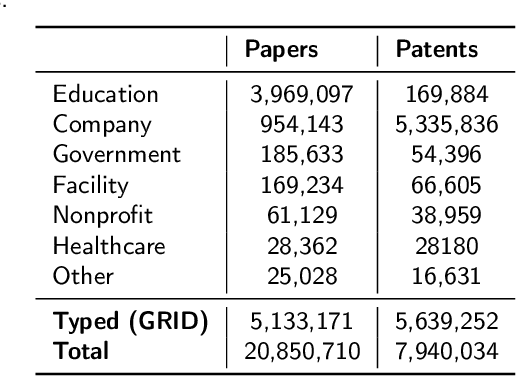
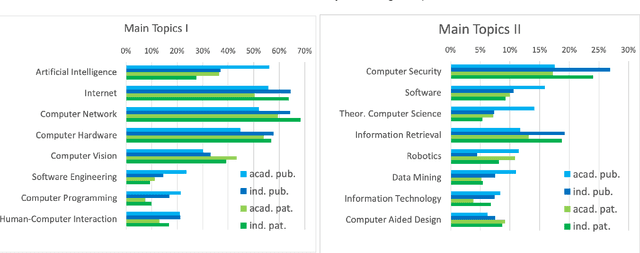

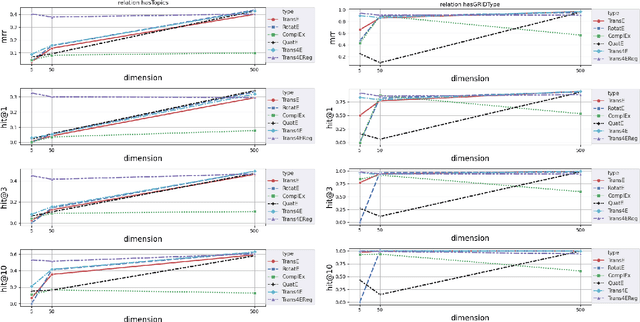
Abstract:The incompleteness of Knowledge Graphs (KGs) is a crucial issue affecting the quality of AI-based services. In the scholarly domain, KGs describing research publications typically lack important information, hindering our ability to analyse and predict research dynamics. In recent years, link prediction approaches based on Knowledge Graph Embedding models became the first aid for this issue. In this work, we present Trans4E, a novel embedding model that is particularly fit for KGs which include N to M relations with N$\gg$M. This is typical for KGs that categorize a large number of entities (e.g., research articles, patents, persons) according to a relatively small set of categories. Trans4E was applied on two large-scale knowledge graphs, the Academia/Industry DynAmics (AIDA) and Microsoft Academic Graph (MAG), for completing the information about Fields of Study (e.g., 'neural networks', 'machine learning', 'artificial intelligence'), and affiliation types (e.g., 'education', 'company', 'government'), improving the scope and accuracy of the resulting data. We evaluated our approach against alternative solutions on AIDA, MAG, and four other benchmarks (FB15k, FB15k-237, WN18, and WN18RR). Trans4E outperforms the other models when using low embedding dimensions and obtains competitive results in high dimensions.
 Add to Chrome
Add to Chrome Add to Firefox
Add to Firefox Add to Edge
Add to Edge